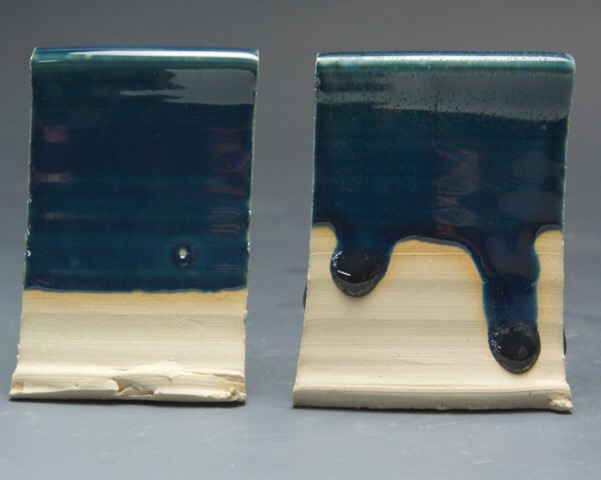Glazes of the same chemistry: The fritted one melts better
It seems logical (and convenient) to just say that the kiln does not care what materials source the insight-live.com/glossary/67">oxides in a glaze melt. Li2O, CaO, Al2O3, SiO2 are oxides (there are about ten common ones). The kiln just melts everything and constructs the glaze from the ones available. Right? Wrong! Things get more complicated when frits are introduced. Frits are man-made glasses, they melt much more readily than raw materials like feldspar. Raw materials are often crystalline. Crystals put up a fuss when asked to melt, often holding on as long as they can and then suddenly melting. Frits soften over a range and they start melting early. To illustrate: These two glazes have the same chemistry. But the one on the left sources sodium and alumina (Na2O3, Al2O3) from the 48% feldspar present. The other sources these from a frit (only 30% is needed for the same amount of Na2O3). The remainder of the recipe has been juggled to match the other oxides. The frit version is crystallizing on cooling (further testament to how fluid the melt is). What has happened here is great. Why? First, the chemistry has not changed (fewer firing differences). The frit has no Al2O3, it is being sourced from kaolin instead, now the slurry does not settle like a rock. Even better, silica can be added until the melt flow matches (might be up to 20%). That will drop the thermal expansion and reduce crazing. The added SiO2 will add resistance leaching and add durability. Frits are great! But you need to know how to incorporate them into a recipe using a little glaze chemistry.
Pages that reference this post in the Digitalfire Reference Library:
A high feldspar glaze is settling, running and crazing. What to do?, Frit, Glaze Chemistry

This post is one of thousands found in the Digitalfire Reference Database. Most are part of a timeline maintained by Tony Hansen. You can search that timeline on the home page of digitalfire.com.
